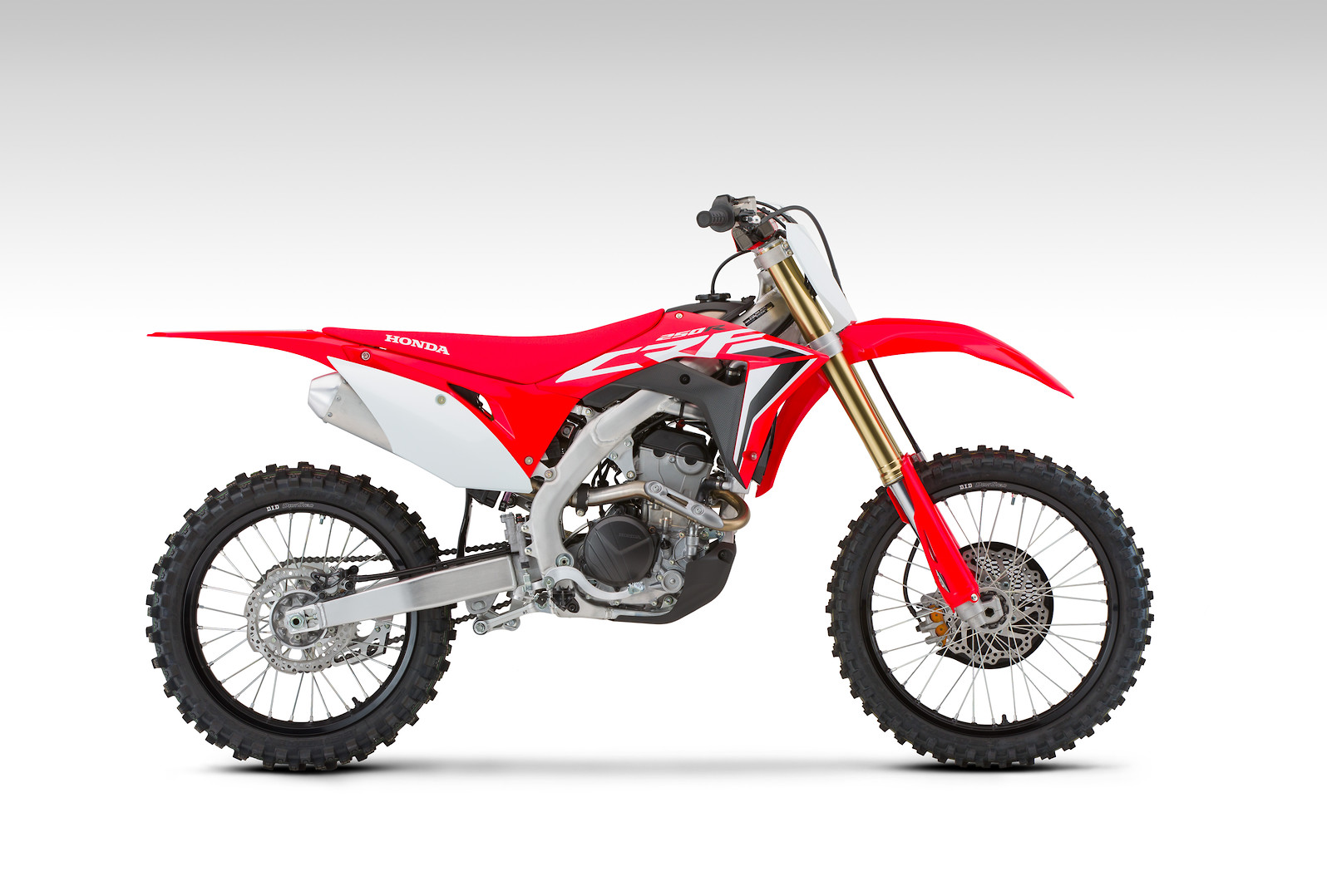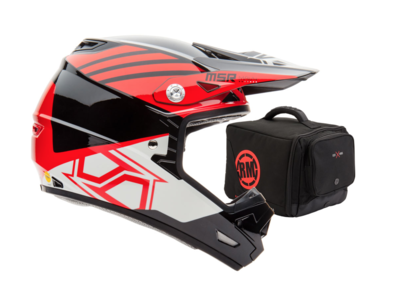2020 Honda CRF250R
This is yet another year that Honda has gone to work on its CRF250R with a long list of changes. In 2018, the bike was changed from the ground up with a whole new engine architecture, frame, and suspension, which made it somewhat surprising that for 2019, they also made changes to boost bottom end power. Apparently, Honda didn’t feel like they did enough because, for 2020, they have made another full list of changes with the same target in mind.
To quickly recap, the all-new 2018 CRF250R was clearly a revver, rather than the previous bike having more bottom to mid-range power. The changes in 2019 helped, but didn’t do enough to get it very high in the 2019 Vital MX 250F Shootout, where it placed fourth overall. Yet it did get a wide range of rankings with one tester giving it a first place, but a few placing it fifth, with a second, a third, and a few fourths.
For 2020, Honda has continued to change and update the latest generation 250R with a focus on more bottom-end power from the motor, better handling from the chassis, and better suspension from, well, the suspension.




2020 Updates to the CRF250R from Honda
- New cam profile delays opening of exhaust valves and has reduced valve overlap, resulting in improved torque and power in the 6,000 - 10,000 rpm range.
- Optimized combustion-chamber shape.
- Ignition timing is optimized at 8,000 rpm for improved torque and power.
- Gear-position sensor added to allow dedicated ignition maps for each gear.
- Header-pipe resonator is removed for improved power character when shifting from second to third gear.
- Muffler is revised for improved low-to-midrange torque.
- New air-filter element is 10% larger for increased airflow.
- Enlarged left-side radiator for efficient cooling with higher engine-power output.
- Second gear has revised (higher) ratio for improved drive, while second and third gears have a new WPC surface treatment for improved durability and reduced friction.Clutch capacity is increased by 18%, and clutch spring has a higher rate.
- New lighter aluminum perimeter frame and aluminum swingarm are designed to achieve increased yaw-angle stiffness while retaining lateral and torsional stiffness, resulting in improved stability.
- Newly shaped footpegs are 20% lighter and shed mud more easily, giving the rider great feel and confidence in all riding conditions.
- Thanks in part to revised internal suspension settings (fork has increased low-speed damping, while shock has increased low-speed compression and reduced high-speed compression), handling has been improved in the following areas: stability, tracking, turning and traction.
- Battery repositioned 28mm lower to drop center of gravity for better handling.
- Rear brake has a shorter hose and longer, lighter pedal, as well as a new pad material with improved power and better durability in muddy conditions. Lower-rear brake guard removed for reduced unsprung weight and improved cooling.
- New graphics.



On The Track: Power
While last year’s machine was better than the 2018 bike, most testers had the same request - More bottom-end, please! With Honda moving to a larger bore and shorter stroke, they’ve moved their CRF250R into the same realm as the KTM and Husqvarnas: higher, quicker revving with top-end focused power. The downside is that a 250cc motor can only make so much power, which can't be strong everywhere. That means, with this kind of motor, that torque and bottom-end snap are sacrificed. The question is, how much? For 2020, we can say that Honda has made a solid effort to bring back some of that bottom-end hit.

Comparing the CRF to the YZ, the Honda is still not as torquey as the YZ and I don’t think anyone would say that the Honda has changed its power characteristic. But what is easy to notice is how much more grunt there is coming out of a corner, getting on the gas hard. Previously, it was a clutch stabbing exercise or, you would have to just wait for the motor to get to the mid-range before it really came to life. Now, especially with a new second gear that is taller (further from first and closer to third), the power comes on much lower in the rpm and pulls you out of the corner much better. Given the overall revvy nature of the motor, you still need to use the clutch from time to time to pop over a jump right out of a 180 or if you were just in a gear too tall. But as our other tester said, Chris Hay, you don’t have to downshift twice coming into a turn like you sometimes did with the older bike.
There are still three engine maps and Honda said that this year they made a concerted effort to make the difference between the maps more noticeable. Personally, I never like map 2 (mellow) because it is usually too mellow for me, but Hay said that it, to him, it didn’t really feel down on power, but just slower revving and probably great for a super slick track. I liked map 3 the best because, with the extra bottom end power from the motor changes, the throttle response is awesome and it just felt stronger across the board. That is another great thing about the 2020 Honda: they seemed to find a way to make more bottom- to mid-range power without giving up any of the top-end and over-rev. Each gear feels very long and very usable throughout the rev range. This feeling might also be from the new gear-position sensor that allows the bike to have a different map for each gear.


All that being said, to get the most out of the bike, you have to stay high in the rpm. Aggressive, throttle happy riders who like to ring bike’s necks will thoroughly enjoy riding the Honda. Unlike some bottom-end powered 250s, there is still throttle response up high with the CRF250R. By that, I mean that even when at the very top of the power, small throttle changes (less or more) still get a quick and noticeable response, where, say, the Suzuki is tapped out and doesn’t really change much when in the high revs.
Overall, is the motor better? That is an easy, Yes. How much better? We’ll have to wait and see. Our hunch is that it might not be enough to dethrone the YZ but we could easily see it close behind with certain orange and white machines.

On The Track: Handling
To be honest, both Hay and I were scratching our heads a bit with the way the bike handled today because, on paper, almost everything got stiffer. The hand-me-down frame and swing arm from the CRF450R is designed to be lighter and have more yaw-angle stiffness (front to back). Also, the fork’s low-speed damping is increased and the shock has increased low-speed compression. The only thing that was softened was the shock’s high-speed. The last couple years, we’ve felt that both 450 and 250 Hondas were on the rigid side when it came to the chassis, so going further that direction wasn’t what we thought the bike needed.
Yet, at the end of the day, we both thought the bike, overall, had a more compliant feel. There wasn’t as much sharp feedback or roughness that we noticed on the last couple CRFs. Not that the bike lost any of its sharp handling characteristics or that it suddenly felt like it was twisting and flexing all over the place. It just felt more comfortable and controllable. Then new frame makes the CRF250R feel short (front to back) in a good way, like the bike is compact, agile, and easy to chuck around. There was a chicane that the Honda flicked through with extremely little effort. The Honda guys were saying that the lower battery made a big difference. I’m thinking it was a contributing factor but probably more the chassis.


Just like in years past, the precise handling of the Honda made it easy to pick the inside rut and lean it in. The Honda is a neutral to front-end steering bike and once I got the bike balanced to my liking (with 100 mm of sag) I could get the CRF to pivot and turn pretty nicely. The Hondas really reward precise turning skills and the bike reacts to rider input really well, even mid-turn. The only time turning was an issue was noticed on flat sweepers or off-camber turns. The rear of the bike wanted to keep sliding a bit.
On The Track: Suspension
Like it was said in the handling section, even though they claim that the bike’s suspension settings are stiffer, we felt like they are smoother and plusher than they have been in the past. Over-jumping or slapping down through rollers wasn’t harsh or painful at all. The fork and shock soaked up the big hits without issue. Even on small hits, I felt like the suspension action was better and more supple.

The only issue I had was a little unpredictability with the front in certain situations (which we had with the 2019 450). I increased the fork compression a click because when I chopped the throttle on certain parts of the track I got some head shake, which was mostly remedied by more compression damping. Also, most the time, I’d have confidence in the front wheel grip when turning, but every once in a while, probably when I was getting lazy or made a mistake, the front would go away really fast, but then recover really fast too. It is just a quick knife or push but then it comes back right away. We both felt this and with more time to play with settings, we think there is a better setup we can find.
Overall
Is this a better CRF250R that last year’s bike? Yes. That much is clear. The more we rode it and got used to it, the faster we rode and the more fun we were having. Pretty much everything that Honda changed this year made the bike do better: Better motor, better handling, better suspension. But to find out how much better we will have to wait until the shootout.
























































0 comments
Post a reply to: First Impression: 2020 Honda CRF250R